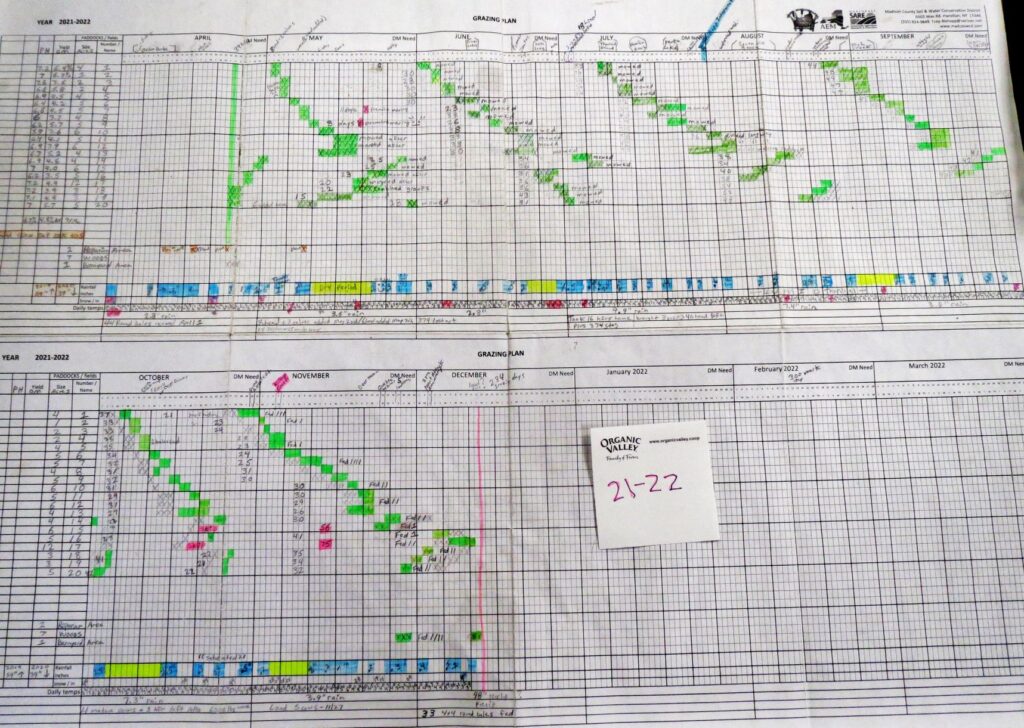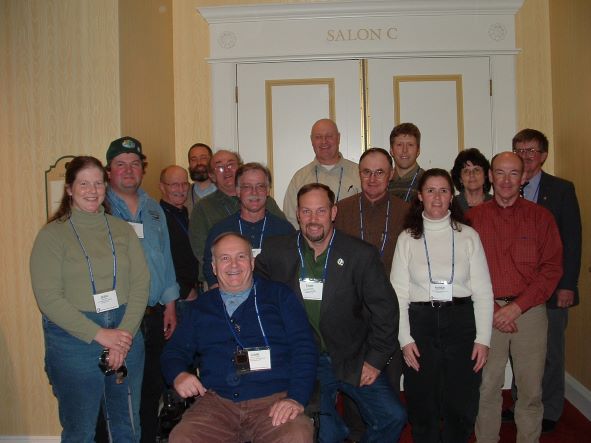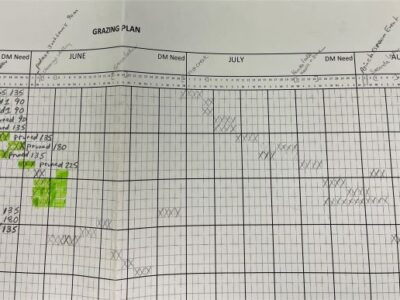by Troy Bishopp
James Weaver from the Finger Lakes Grazier’s Group asked me to reflect on keeping a grazing chart. This request launched me into a personal history lesson of sorts looking over a twelve-year period of proactive grazing management, not reactive. It became quite clear; I’ve been through a lot in 12 years. And this history is on all of my grazing charts paired with thousands of date-stamped pictures of activities. My grazing chart has become more than a production and decision-making tool; it is my diary of life.

The 24” x 30” piece of paper has been a great tool to almost pressure management because you have to observe daily and collect data in order to actually fill it out and get anything useful out of it. This simple tool, taped to a door I have to go through, forces me to pause and think about a myriad of things on my plate. The habitual discipline has helped our grazing operation create healthy diverse swards, optimize animal performance, plan more grandchildren/family days and become increasingly resilient against the forces of nature.
If I’m honest, it wasn’t always so. However, “To everything there is a season, and a time to every purpose under the heaven” ~ Ecclesiastes 3:1.

My journey to improvement really started in 2006 when I was asked to speak at the National GLCI Grazing Conference in St. Louis, but preloaded a trip up to visit Greg and Jan Judy’s farm above Columbia, Missouri. Of course, the “Gregster” with his signature headlamp, amused me with his holistic tenor and excitement while completely wearing me out with his work ethic; to I guess, save humanity using the magic of grass and microbes. Awakening from my slumber, I found out soon enough, the “Microbe Messiah” literally had a boardroom that was wallpapered with grazing charts, notations, maps and stock flow-charts. As we chatted back to Saint Louie for the conference, I decided I needed to up my grazing game and follow my mentor for a better life.
It’s funny how opportunities arise when you become enlightened to accept them. Around the same time, Jim Gerrish introduced me to his grazing wedge, a band of Northeast holistic brothers introduced me to Holistic planned grazing, monitoring and decision-making matrixes, the Carbon Cowboy, Neil Dennis and I were talking about mob grazing and soil health while the incomparable Jerry Brunetti was filling my head with nature’s fixes. Allan Savory, Ian Mitchell-Innes and Ben Bartlett’s teachings were also having a profound effect on my context. Things were lining up for me in 2010 as a now practitioner of ecosystem processes and Conservation District Grazing Specialist. Turns out, successful grazing and land managers use a plethora of grazing tools, including a grazing planning/record-keeping system.
My early days of using a grazing chart are the same questions asked today. What should be on it? How do you get started? What’s the right way to do it? How do you plan for the future? What if I’m too busy and can’t keep it current? Is there a recipe I can follow? What do get when your done with it?
I have attempted to answer many of these questions with my writing contributions, resource materials and sharp tongue at pasture events. Honestly, I followed a template from the Holistic Management Handbook and made it my own and kept practicing and refining to my liking. To get the most out of the decision-making process, I had to commit to the principles laid out by my mentors: Observation, measuring, balancing forage and animal needs, grazing management techniques with a field-by-field perspective and constantly monitoring the weather and ensuring recovery periods were appropriate.
I remember it clearly, as a newbie, putting pencil X’s in the boxes where the cattle were grazing. And then taking the leap of faith to write in what the next ten days might look like. And then another 10, and another 10. Suddenly, I was planning, recording, making grazing decisions and managing everything better. I was making plans in consideration of grassland bird habitat, stockpiling and time off. I was watching the rain gauge much closer, looking at plant growth rates and gaining more quality grazing days, earlier and later into the growing season. And low and behold, making more money.
As I looked back on this journey of grazing journaling, it becomes a historic record of decision-making and a place where basic trends start to emerge on how your management is working towards your specific goals.
For our operation under my management, I have seen these trends and actions taken on our farm over the last 12 years:
- Average organic matter levels have increased to 4.6%
- Fertility levels have been maintained or improved using only basic inputs
- Low fuel cost to perform activities
- Animal performance has improved and is more consistent (>1.8lbs/hd/day)
- Averaging 55 more grazing days per year
- Less yearly grazing cycles (5) but more average recovery days (>35-40)
- Increased biodiversity
- Planted over 1000 trees for shelterbelts and habitat improvement
- Hunting lease initiated
- Verifying grazing practices lowered organic inspection time by hours
- Water infiltration and retention has significantly improved
- Average 2 weeks more growing season in fall (Av. frost date moved to October 22nd)
- More frequent rainfall events over 2 inches
- Less snow days and frozen ground
- More camping days per season (>29)
- Had our first-ever farm wedding
- Steady cash flow
- Less stress
- More overall resiliency for operation and humans

Probably the most poignant moments and reflection in chronicling on my grazing chart (or life chart) have been really personal in nature. There in the headings are births of my grandchildren, marriages, birthdays, anniversaries, awesome vacations, conferences, special times with friends, my heart attack and my most tragic entry—my brother’s untimely death in 2017. I hold no patents or recipes for what may work for this audience of grazing practitioners but I encourage you to take a long look at your goals and see if you have enough of the right tools to reach your objectives.
Should you keep a grazing chart, diary, journal or recordkeeping software? It’s not for me to say. However, I would counter with this question: Why wouldn’t you?


 Dutch Farmers “Opstand”
Dutch Farmers “Opstand” »
»